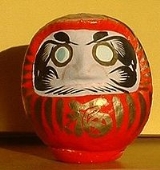
Daruma doll
Encyclopedia
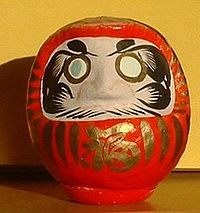
Japanese traditional dolls
Japanese traditional dolls are known by the name in Japan, which literally means human shape.There are various types of Japanese dolls, some representing children and babies, some the imperial court, warriors and heroes, fairy-tale characters, gods and demons, and also people of the daily life of...
modeled after Bodhidharma
Bodhidharma
Bodhidharma was a Buddhist monk who lived during the 5th/6th century AD. He is traditionally credited as the transmitter of Ch'an to China, and regarded as the first Chinese patriarch...
, the founder of the Zen
Zen
Zen is a school of Mahāyāna Buddhism founded by the Buddhist monk Bodhidharma. The word Zen is from the Japanese pronunciation of the Chinese word Chán , which in turn is derived from the Sanskrit word dhyāna, which can be approximately translated as "meditation" or "meditative state."Zen...
sect of Buddhism
Buddhism
Buddhism is a religion and philosophy encompassing a variety of traditions, beliefs and practices, largely based on teachings attributed to Siddhartha Gautama, commonly known as the Buddha . The Buddha lived and taught in the northeastern Indian subcontinent some time between the 6th and 4th...
. These dolls, though typically red and depicting a bearded man (Dharma), vary greatly in color and design depending on region and artist. Though considered an omocha, meaning toy, Daruma has a design that is rich in symbolism and is regarded more as a talisman of good luck to the Japanese. Daruma dolls are seen as a symbol of perseverance and good luck, making them a popular gift of encouragement. The doll has also been commercialized by many Buddhist temples to use alongside goal setting.
Bodhidharma
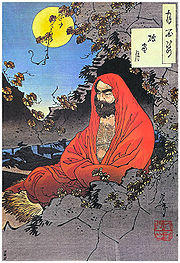
Bodhidharma
Bodhidharma was a Buddhist monk who lived during the 5th/6th century AD. He is traditionally credited as the transmitter of Ch'an to China, and regarded as the first Chinese patriarch...
was a Tamil monk from the southern region of India
India
India , officially the Republic of India , is a country in South Asia. It is the seventh-largest country by geographical area, the second-most populous country with over 1.2 billion people, and the most populous democracy in the world...
and founded Ch'an, Zen
Zen
Zen is a school of Mahāyāna Buddhism founded by the Buddhist monk Bodhidharma. The word Zen is from the Japanese pronunciation of the Chinese word Chán , which in turn is derived from the Sanskrit word dhyāna, which can be approximately translated as "meditation" or "meditative state."Zen...
Buddhism
Buddhism
Buddhism is a religion and philosophy encompassing a variety of traditions, beliefs and practices, largely based on teachings attributed to Siddhartha Gautama, commonly known as the Buddha . The Buddha lived and taught in the northeastern Indian subcontinent some time between the 6th and 4th...
. Bernard Faure, Professor in Japanese Religion at Columbia University
Columbia University
Columbia University in the City of New York is a private, Ivy League university in Manhattan, New York City. Columbia is the oldest institution of higher learning in the state of New York, the fifth oldest in the United States, and one of the country's nine Colonial Colleges founded before the...
, explains in his article, Bodhidharma as Textual and Religious Paradigm, that the events behind Bodhidharma's life are "very obscure," thus history concerning him is viewed more as a "literary piece." There is mention of Bodhidharma in many historic records, but no direct biographical records. They show Bodhidharma spending days in silence or several hours in songs of praise. Based on these citations, Faure concludes that "historians have harmonized these conflicting images of Bodhidharma as a devout and somewhat senile monk." Most people in Japan are more familiar though with the legend of Bodhidharma. Helen B. Chapin explains in her article Three Early Portraits of Bodhidharma, which was published in 1946, that Bodhidharma is believed to have been born as the third son to a king in South India
India
India , officially the Republic of India , is a country in South Asia. It is the seventh-largest country by geographical area, the second-most populous country with over 1.2 billion people, and the most populous democracy in the world...
. He then, following the instructions of his old master, left his kingdom to live in China. He immediately gained a reputation for, among other things, his practice of wall-gazing. Chapin mentions that the legend also claims that he sat facing a wall in meditation
Meditation
Meditation is any form of a family of practices in which practitioners train their minds or self-induce a mode of consciousness to realize some benefit....
for a period of nine years without moving, which caused his legs to fall off from atrophy
Atrophy
Atrophy is the partial or complete wasting away of a part of the body. Causes of atrophy include mutations , poor nourishment, poor circulation, loss of hormonal support, loss of nerve supply to the target organ, disuse or lack of exercise or disease intrinsic to the tissue itself...
. Another popular legend is that after falling asleep during his nine-year mediation, he became angry with himself and cut off his eyelids to avoid ever falling asleep again. His discarded eyelids are said to have sprouted the first tea plant.
History and commercialization
The current popular symbolism associated with Daruma as a good luck charm in part originated with the Daruma-dera (Temple of Daruma) in the city of Takasaki (Gunma Prefecture, north of Tokyo). Josef Kyburz, Author of "Omocha": Things to Play (Or Not to Play) with, explained that the founder of Daruma-Dera would draw New Year’s charms depicting Bodhidharma. The parishioners would keep these charms to "bring happiness and prosperity and ward off accidents and misfortune".It is believed that the Daruma figurine then originated from this region when the ninth priest, Togaku, found a solution to handle the constant requests of the parishioners for new charms. The charms were always given with an effectiveness of one year, so the people required new ones every year. He solved this by entrusting them with the making of their own Daruma charms near the beginning of the Meiwa
Meiwa
was a after Hōreki and before An'ei. This period spanned the years from June 1764 through November 1772. The reigning empress and emperor were and .-Change of era:...
Period (1764–72). The temple made wooden block molds for the people to use. The peasants then used these molds to make three-dimensional papier-mâché charms.
Kyburz notes that though it is unknown when the Daruma figurine combined with the tumbler doll
Roly-poly toy
A roly-poly toy, round-bottomed doll, tilting doll, tumbler or wobbly man is a toy that rights itself when pushed over. The bottom of a roly-poly toy is round, roughly a hemisphere. Many roly-poly toys are hollow, with a weight inside the bottom. It has a center of mass below the center of the...
, the two were well recognized as synonymous by the mid-19th century. The doll quickly grew in popularity, becoming a mascot of the region. This was due greatly in part to fact that the majority of the families were silk farmers, a crop which requires a great deal of luck for success.
There is an annual held by the city of Takasaki in celebration of being the proclaimed birthplace of the Daruma doll. The celebration is held at the Shorinzan, the name of Takasaki's "Daruma-Dera". According to the Takasaki City website, "Over 400,000 people from all over the Kanto Plain come to buy new good-luck dolls for the year. Takasaki produces 80% of Japan's Daruma dolls." The festival also features a 24-hour reading of sutras by the Shorinzan monks for world peace.
Physical features and symbolism
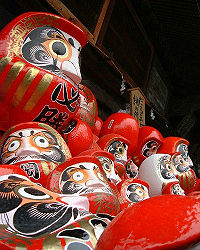
Shape
Darumas are still usually made of papier-mâché, have a round shape, are hollow, and weighted at the bottom in a way that it will always return to an upright position when tilted over. In Japanese a roly-poly toyRoly-poly toy
A roly-poly toy, round-bottomed doll, tilting doll, tumbler or wobbly man is a toy that rights itself when pushed over. The bottom of a roly-poly toy is round, roughly a hemisphere. Many roly-poly toys are hollow, with a weight inside the bottom. It has a center of mass below the center of the...
is called okiagari. meaning to get up (oki) and arise (agari). This characteristic has come to symbolize the ability to have success, overcome adversity, and recover from misfortune.
Due to this, Daruma is often illustrated alongside the phrase "Nanakorobi Yaoki", translated to mean seven times down, Eight times up. This is seen in the popular culture on cards, banners, and books. One example of this is Dr Alan Gettis' Book entitled, "Seven Times Down, Eight Times Up: Landing on Your Feet in an Upside-down World". Recalling the Story of Daruma-san in the introduction of his book, Dr. Gettis describes the phrase as "a call to never give up."
The tumbler doll style is similar to an earlier toy called the Okiagari Koboshi, the little self-righting monk which was popular in the Kinki region during the mid-17th century. The original okiagari toy, however, is said to have been introduced from Ming China around 1368-1644.
Color
Though it is not certain, the origins of Daruma’s traditional red coloring probably came from the color of priest’s robes. Reliable sources in English were hard to find, but one Japan-based website cites his red as being the "color of the robe of a high-ranking priest." The author then concludes that "since Daruma was the founder of the Zen Sect, he must have worn a red robe." James T. Ulak, head of Collections and Research substantiated the history of Bodhidharma paintings depicting him wearing lavish red robes, prior to ever being made into a doll, in his article entitled Japanese Works in The Art Institute of Chicago.By virtue of his red robes, Daruma has come to play a role in recovering from sickness. During the late Edo period
Edo period
The , or , is a division of Japanese history which was ruled by the shoguns of the Tokugawa family, running from 1603 to 1868. The political entity of this period was the Tokugawa shogunate....
(1600’s to 1868), red was believed to have a strong association to smallpox
Smallpox
Smallpox was an infectious disease unique to humans, caused by either of two virus variants, Variola major and Variola minor. The disease is also known by the Latin names Variola or Variola vera, which is a derivative of the Latin varius, meaning "spotted", or varus, meaning "pimple"...
. Hartmut O. Rotermond, author of Demonic Affliction or Contagious Disease?, describes that in Edo and surrounding cities, there were many outbreaks of measles and smallpox. In present day Japan, there are many red shrines dedicated to a God of Smallpox, which had a particular liking for red. These shrines were built in response to those outbreaks. Believing that the God of smallpox, if pleased, would spare the inflicted child, the Japanese would often stretch out ropes around the house strung with red paper strips, have the child wear a red robe, and make a small altar for the God to put talisman like Daruma figurines on. These precautions were also used to warn others that sickness was in the house, and to encourage cleanliness around the sick. The red of Daruma, however, was used to pacify the God, while the image of okiagari was to encourage the patient to recover as quickly as they fell ill.
Daruma can also be purchased in set of five colors called "Goshiki Daruma."
Eyes
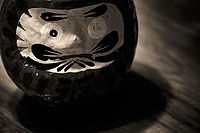
The politicians during election time are a good example of this. Political parties are often seen at their headquarters with large Daruma dolls and amulets purchased from local shrines as a prayer for victory. This practice has been followed for some time and is highlighted in a 1967 article in Time Magazine titled Japan: The Right Eye of Daruma. After explaining the legend of "complet[ing] the Daruma's missing eye as a symbol of gratitude for otherworldly intervention," the article recounts the following event: "Last week, in the Tokyo headquarters of Japan's ruling Liberal Democratic Party, Premier Eisaku Sato dipped a sumi brush into an ink stone and with swift strokes daubed in the dark right eye of his Daruma. ‘The eyes,’ he remarked when he had finished, ‘are as big as my own.’"
Facial Hair
Daruma’s facial hair is a symbolic representation of the animals well known in Asian culture to embody longevity, the crane and the tortoise. The eyebrows are in the shape of a crane, while the cheek hair resembles the shell of the tortoise. A Japanese-based website states that originally, there was a snake or dragon depicted across the moustache and cheeks, but was changed to tortoise to emphasize the desire for longevity. In this way, Daruma was designed to match the Japanese proverb "The crane lives 1000 years, the tortoise 10,000 years."Daruma burning
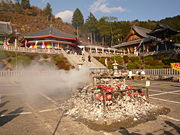
Feminine representations of Daruma
Daruma dolls also come in the form of and . This contrasts greatly with traditional representations of Dharma, who, accredited as the father of many martial arts, has traditionally been depicted as very masculine with rough facial hair. H. Neill McFarland, Professor of Theology, discusses the feminine representations of Bodhidharma in his article Feminine Motifs in Bodhidharma Symbology in Japan. The answer to this anomaly lies in the social changes at the time, developing in the Edo Period. The class distinctions placed the merchants at the bottom, who in turn developed their own culture focusing on humor and poking fun at what those of higher class held sacred. This is evident in the depiction of Dharma as a prostitute since prostitutes displayed the same "okiagari" resilience. Famous pieces of art depicting Bodhidharma were also redrawn with a woman in his place.With the inception of the Daruma doll, the Onna Daruma doll quickly followed. Though the before mentioned examples of feminine motifs of Daruma were satirical, the doll forms maintain the same wholesome image of a bringer of good luck.
Children's games
Many children's games make mention of Daruma. The Japanese equivalent of a snowmanSnowman
A snowman is an anthropomorphic snow sculpture. They are customarily built by children as part of a family project in celebration of winter. In some cases, participants in winter festivals will build large numbers of snowmen...
is a , literally snow daruma. Darumasan ga koronda is an equivalent to the American Red light/Green light game. Daruma Otoshi is a traditional game played with a daruma doll in five pieces, usually in the colors of the rainbow, from top to bottom: head - a man's face, blue, green, yellow, red. The game is played by using a small hammer to hit each of the colored pieces, from bottom to the top, without letting the pieces fall during the game.
Discrimination against the blind
In the late 1990s, several groups of human rightsHuman rights
Human rights are "commonly understood as inalienable fundamental rights to which a person is inherently entitled simply because she or he is a human being." Human rights are thus conceived as universal and egalitarian . These rights may exist as natural rights or as legal rights, in both national...
activists claimed that the practice of making Daruma without eyes (and the practices associated with them) is discriminatory against the blind. Some media organizations and politicians eager to avoid negative publicity stopped showing eyeless daruma altogether. It used to be a signifying moment in an election to have the winner draw an eye, but this is no longer shown.
See also
- Religions of Japan
- Matryoshka, a Russian doll said to be inspired by the Daruma doll

